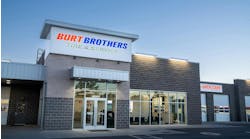It has been said that convincing someone to buy from you and influencing an employee to produce more than required are similar in nature.
In my years of coaching, I have come to the conclusion that this is true, even though by definition, the two things are different. For example, influence will most often induce change, whereas persuasion means to sway others’ decisions.
The common denominator, however, is that both require a sales process to make them a reality. Let’s take a look at how we persuade others intentionally through the sales process.
First, let’s look at the power of a question. When we engage employees in the leadership process or engage customers and prospects in the sales process, we must understand that the only way to gain buy-in and to make sure they are listening is to ask questions.
When we ask the right question at the right time and in a way that does not come across as an interrogation, we can be 100% sure they are listening.
Many times, we think about what we initially want to say, but instead of coming out and saying it to another person, we form our thoughts into the best question that will get our point across.
The benefit of asking the right questions with the right timing and teeing up the question with the current situation is simple: trust is accelerated!
Questions need to be asked in such a manner that the other person will buy the idea you are “selling.”
Furthermore, good questions should get the person to talk, so you can learn more about their needs and how you, as business leaders or salespeople, can meet their expressed needs.
Often, there are needs hidden behind an originally expressed need that can only be uncovered through disciplined question-asking.
Once this has been mastered, leaders can lead at a higher level, salespeople can sell more effectively, employees become more engaged, teams function better and profits can skyrocket. And even better, the foundation is laid for maximum trust.
The power of trust
Leadership and sales training books are replete with explanations of the value of trust. Trust is vital to get employees to do more than expected and it is the foundation that will convince a customer to buy more from you. When trust is present, the machine runs smoother.
The challenge is that most leaders and salespeople don’t know how to gain trust and don’t understand when they have lost trust. We hear it every day when we analyze phone calls, during which a salesperson has asked the wrong questions, made the wrong statements and or used an inappropriate word.
In situations like this, we immediately hear the customer end the call by telling the salesperson they will “let them know” or that they plan to get more options and/or a second opinion. For the unexperienced salesperson, this is confusing and many times demoralizing because they unintentionally lost a sale.
The same thing can happen between business leaders and employees. Consider a business owner or leader who meets with an employee about not being on his or her cell phone when working the sales counter, only for that leader to answer or check his own phone a few minutes later.
This will cause the employee to not trust the leader. Sometimes it will cause the employee to become disgruntled and disengaged.
In leadership and sales, there is an “influence wake,” much like a boat moving across a lake. When you engage an employee or a customer, you influence them positively or negatively.
When dealing with employees or customers, the relationship must be present and healthy. For this to happen, you have to be intentional with every interaction.
When asking for more results from employees or more sales from customers without having a relationship with them, a leader will be seen as a tyrant and a salesperson will be seen as “high pressure.”
To have a relationship that produces no results, a leader will often be seen as a doormat and a salesperson will be viewed as someone who can’t be trusted.
This is precisely why we must be intentional with every word we speak to employees, as well as customers.
The power of words
As we mentioned before, during our consultations, we have heard potential customers literally decide not to buy because a salesperson used the wrong words or the wrong arrangement of words during an interaction.
Instead of telling a customer, “You’ll have to wait until next week” or “I don’t have that tire in stock,” it’s advisable to substitute a more positive statement, such as, “I can schedule your installation for 10 a.m. next Tuesday or next Wednesday at 10 a.m. Which one works best?”
Tire dealers have seen millions of dollars of sales evaporate because the salesperson said to the customer, “I can’t get that tire.” In all interactions with customers, negative words like, “can’t,” “don’t” and “will not” should never be used. You should only communicate what you “can” do.
Making an “I can” statement, in fact, can calm many customers.
Also make sure you are calculated with the use of your words and avoid using filler words when you try to accelerate trust. Business leaders must also choose their words carefully and project positivity when talking with employees.
It’s easy to lose trust and damage productivity by not using the correct words. Good employees do not respond to being barked at or told to do things. But they do respond to being asked and they love to be thanked. We train our clients to always look for opportunities to say thank you.
You may think that I am being too detailed and picky, but learning to speak well and use the right words are a necessity due to the number of choices the consumer has in most markets.
I once had a salesperson tell me that he had 37 competitors within three miles of his location.
Situations like that can be problematic for tire dealers who have no clear vision or training program, as well as no sales and leadership process.
The power of choice
How can you convince employees to spend that extremely valuable currency called “extra effort” on you, your business and most importantly, your customers? And how can you persuade customers to spend their hard-earned money with you?
When customers call your store, they are letting you know that if you can execute on what we have discussed in this article, they will do business with you, assuming your price is somewhat competitive.
The fact that they “chose” to call you is already a positive, even though it’s not a done deal until an installation and/or appointment is scheduled. You now have an opportunity to woo the person who is calling you.
How do you accomplish this? One way is to simply give the customer at least two options for products and appointment times. Why? Many customers hate to waste their time waiting. (Very few salespeople know how to capitalize on this.)
Harvard Business Review did a study on how people make choices in situations. When one option is offered, the adoption rate is typically only 10%. However, when Option A and Option B are offered, the adoption rate skyrocketed to 75%, with Option A receiving 38% and Option B 37%
The same psychology is true when motivating employees. Leaders should always give at least two options in any scenario.
If more owners/managers and salespeople remember that people will always have a choice, they will be motivated to learn more, train more and fight harder for the sale or adoption of an idea. Ask the right questions, choose your words wisely and present choices.




